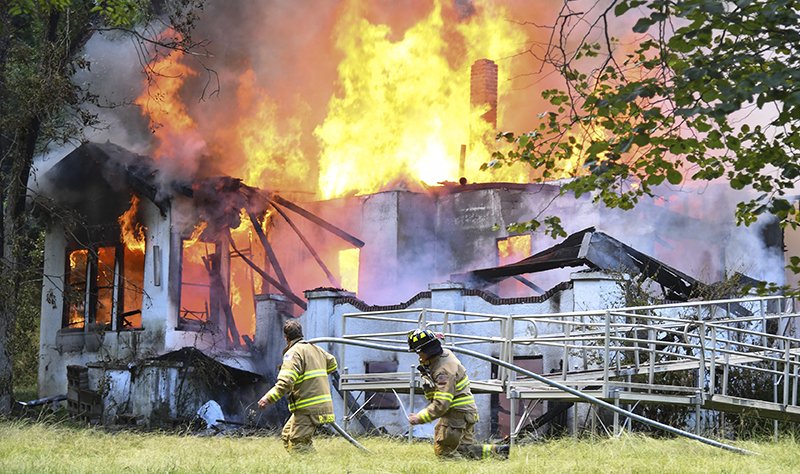The Hot Springs Fire Department combated the weather as well as a blazing house fire on Walnut Street Wednesday afternoon, with two firefighters receiving intravenous fluids as temperatures soared into the upper 90s.
Hot Springs Fire Chief Ed Davis said 18 firefighters responded to the fire in the 400 block of Walnut Street. Due to the heat, Davis said they called in six off duty firefighters to work overtime.
The fire, which broke out in the reportedly vacant house at around 2:30 p.m., resulted in a downed power line and Entergy was called to the scene.
Firefighters worked from three different sides of the fully engulfed house, using hoses on each side and a water cannon from the street. In addition to working to put out the blaze, firefighters also worked to keep the fire from spreading to a nearby home. Although the fire did not spread, the neighboring home's siding visibly melted due to the excessive heat.

In an attempt to keep the firefighters safe from the heat, Davis said the firefighters were taking shifts. During the active firefight, each firefighter had a 20-minute shift. Once the scene was no longer considered an active firefight, the shifts were longer, between 30 and 40 minutes.
Each firefighter who ended their shift was examined by a medical team, Davis said, which looked for signs like "pale, clammy look, fixed stare, profuse sweating or if they've stopped sweating." He noted if they have stopped sweating, then the situation is more dangerous.
If those signs were present, Davis said, "we refer them to the medics ... LifeNet will give them an IV."
At one point, Davis said one firefighter needed an IV. "I think he'll be fine (once he) becomes hydrated," he said, noting the firefighter had stopped sweating. A few minutes later, Davis said a second firefighter was also receiving an IV.
The firefighters were also given a cold towel and had a cooling station where they could remove their turnouts and sit down. Davis said that, depending on the firefighter, each is carrying between 35 and 50 pounds between turnouts and equipment.
To prepare for fighting fires in hot weather, Davis said the firefighters "load up on liquids, preferably water," or drinks with electrolytes. He said they do most of their training in the summer months earlier in the day to keep the firefighters safer.
Hot Springs was under a heat advisory on Wednesday due to the hot and humid conditions.
By 4 p.m., around the time firefighters were at the scene, the air temperature was 98 degrees, according to the National Weather Service observation station at Hot Springs Memorial Field, with 40 percent relative humidity.
Rain might provide relief to some areas today; the Weather Service forecast calls for a 40-percent chance of thunderstorms today, mainly after 10 a.m., with a high near 92.
On Friday, the forecast high is near 88, with a 60-percent chance of precipitation.
"Take extra precautions if you work or spend time outside. If possible, reschedule strenuous activities to early morning or evening. Wear lightweight and loosefitting clothing and drink plenty of water," the heat advisory stated.
"If you must be outdoors, the occupational safety and health administration recommends taking frequent rest breaks in shaded or air-conditioned environments. Anyone overcome by heat should be moved to a cool and shaded location. If heat stroke is suspected, call 911," it said.
"Young children and pets should never be left unattended in vehicles under any circumstances. This is especially true during warm or hot weather when car interiors can reach lethal temperatures in a matter of minutes."
Local on 08/22/2019
